This yummy toddler smoothie method is simple to blend up and even easier to customize for breakfast or snack time. It’s a perfect smoothie for kids since it’s naturally sweet, loaded with nutrition from fruit and veggies, and tastes great! Plus: The one master recipe can be made 10 easy ways.
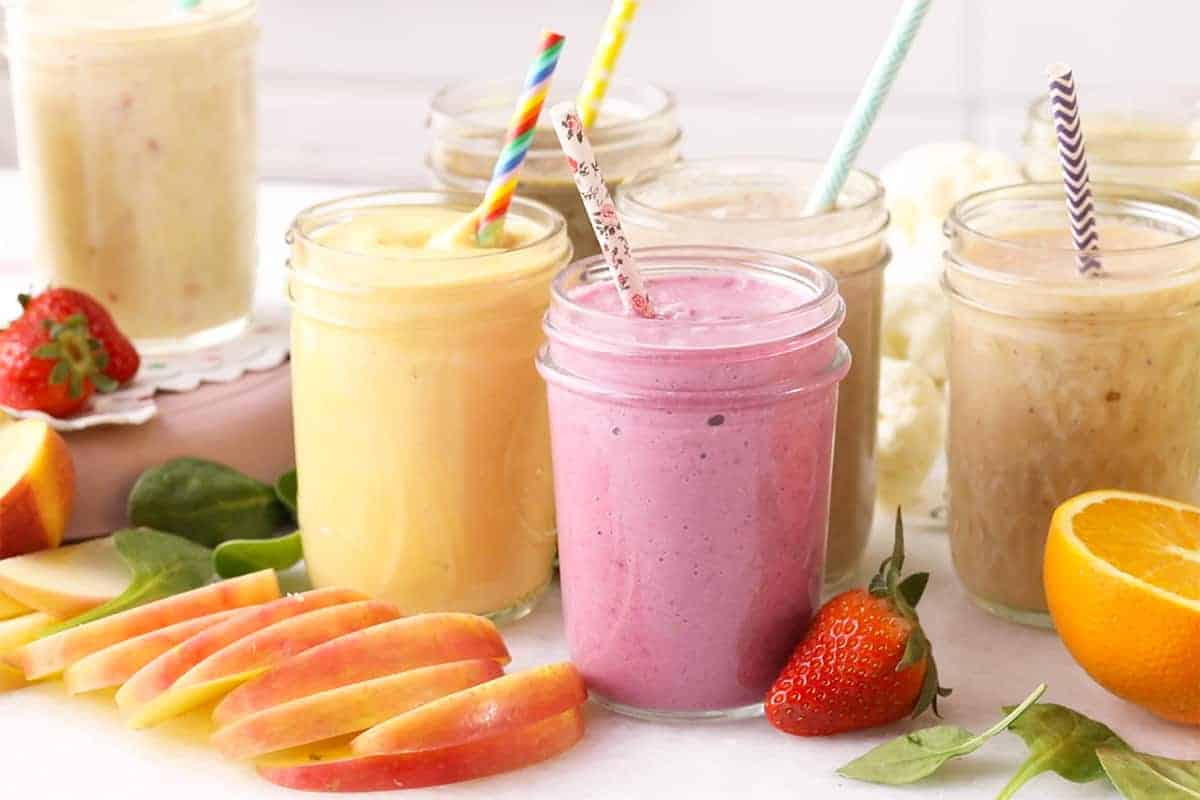
Healthy Toddler Smoothies
One of the best ways to help your toddler and older kids eat more fruits and vegetables is to pack them into smoothies. By starting with one master smoothie recipe and varying it based on what your kids like (and for any food allergy concerns), you can increase the likelihood that they will actually drink it—which is clearly key!
This recipe is flexible and versatile.
To be completely honest, my oldest has never been a fan of smoothies. Because of that, I tried very hard to get my second and third kids to like them right from the start. I make them smoothies a few times a week so they are familiar and I’m happy to report that she’s a total fan.
We love smoothies for healthy breakfasts and snacks. And it’s nice that you can keep almost all of the ingredients on hand in the freezer or pantry.
Table of Contents
- Healthy Toddler Smoothies
- Smoothies for Kids
- Ingredients You Need
- Step-by-Step Instructions
- Smoothies for Toddlers with Food Allergies
- Kid-Friendly Constipation Smoothie
- Smoothies for Toddlers to Gain Weight
- Frequently Asked Questions
- Best Tips for Success
- Favorite Healthy Toddler Smoothie (with Veggies!) Recipe

Smoothies for Kids
One of my best tips for helping kids like smoothies is to avoid packing them too full of extras. Because if you go overboard on veggies and things like chia seeds, a kid smoothie can taste like sludge really fast. But thankfully, you can still make a healthy smoothie that’s packed with nutrition if you know how to balance the ingredients.
TIP: If your toddler regularly drinks milk at breakfast, try switching to smoothies some days. This has the benefit of allowing you to fill their bellies with a range of nutrition and flavors.
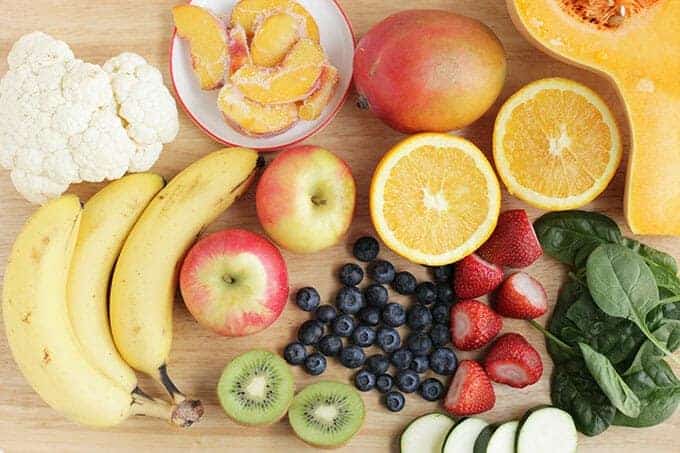
Ingredients You Need
There’s one master recipe here, but you can pick which fruits and veggies to use so you can customize it for your child.
Generally you’ll need:
- Milk (I prefer non-dairy)
- Fruit
- Veggie
- Frozen banana
- Optional add-ins
TIP: I like to do half frozen fruit and half fresh fruit to avoid having a smoothie that’s a nice and easy thickness for toddlers to drink.
Step-by-Step Instructions
Here’s a look at the process involved in making smoothies for kids. Scroll down to the bottom of the post for all of the recipes.
- Add the milk to the blender. (We prefer nondairy milks since they seem to have a slightly better consistency and less of a tendency to separate after blending.)
- Add the fruit and veggie.
- Add any optional ingredients.
- Blend the smoothie really well to ensure that it has a very creamy texture.
- Serve it in a reusable pouch, a small open cup, or in a sippy cup depending on what your kid likes best.
TIP: To help ensure a good texture and flavor in our veggie smoothies, we pick just a few ingredients each time and keep the flavors simple.
Smoothies for Toddlers with Food Allergies
If your toddler has food allergies, it’s easy to adjust a smoothie for them. If they are allergic to bananas, use 2 tablespoons avocado instead or try a teaspoon or two of nut butter. Use whichever type of milk you prefer—almond, flax, coconut, rice, dairy, or even kefir.
We tend to use Silk Protein Nut Milk, Ripple Milk, or New Karma Flaxmilk in our smoothies.
Kid-Friendly Constipation Smoothie
If your toddler has frequent constipation or a sudden bout, a smoothie with hidden veggies can help. Consider adding chia seeds or hemp seeds, and a small spoonful of coconut oil, flaxseed oil, or avocado. You can also use full-fat coconut milk as the base.
The healthy fats can coat the digestive tract, making it easier for food waste to pass through. And, since the foods in toddler smoothies are already blended, it’s much less work for their digestive systems!
TIP: This is my best Constipation Smoothie recipe.
Smoothies for Toddlers to Gain Weight
If your doctor has told you that your toddler needs to gain weight, a smoothie can be a helpful mealtime tool. Consider adding nut butters, avocado, healthy oils (flax, fish), full fat yogurt, hemp seeds, and offering a serving of a toddler smoothie at snack time, mealtime, or as a bedtime snack.
Use those in between times to get in a little extra nutrition and calories (though remember that we can’t impact how hungry our kids feel).
TIP: Find more foods to help toddlers gain weight here.
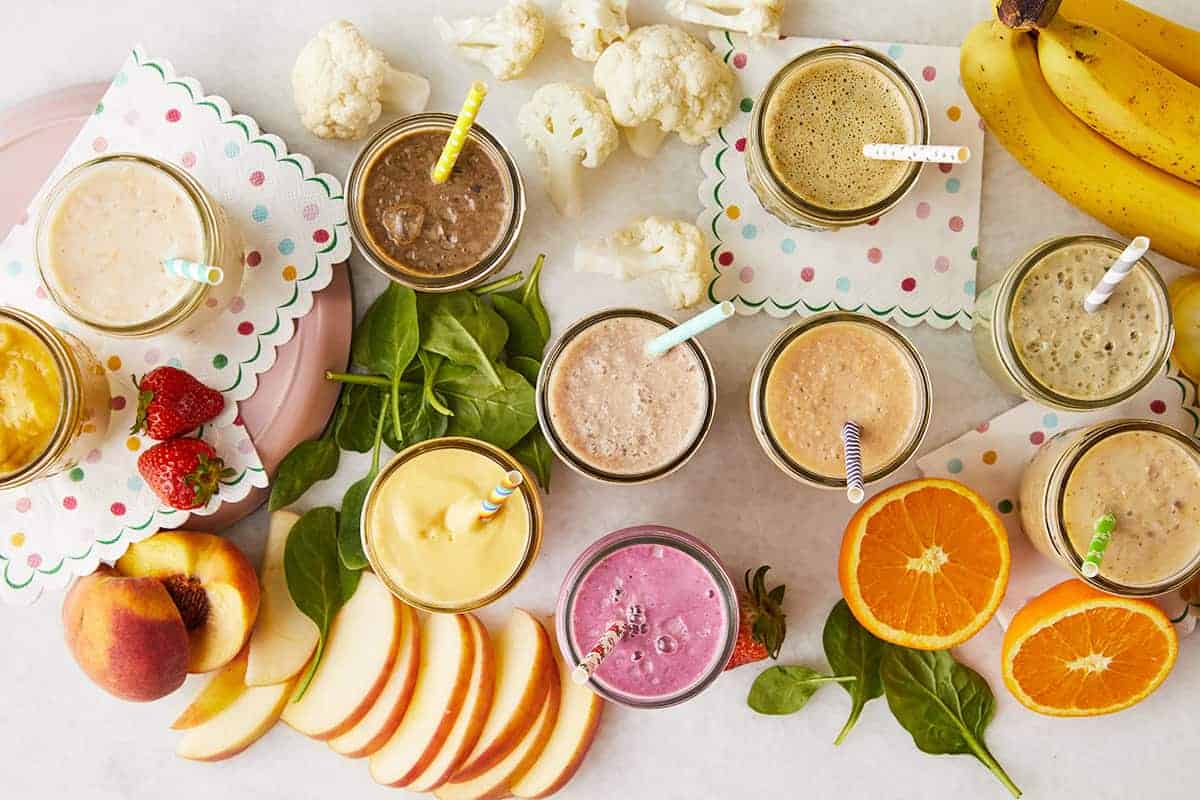
Frequently Asked Questions
After a baby is eating solid foods, they can start smoothies almost right away. Avoid using sweetened milks and opt for a plain unsweetened nondairy milk instead. And serve on a spoon, in a very small open cup or in a reusable pouch. (You just don’t want to substitute it for breastmilk or formula.)
If you have a kid who won’t eat many vegetables, veggie smoothies can be a great option since the veggies are served in a slightly sweet drink that tastes like a milkshake. Resist the urge to add more of any vegetable than my recipe below because that may impact the flavor or texture. And be sure to blend them very, very well.
And try some of the combinations below that aren’t green first, since pink, orange, purple, or even white smoothies are often much less alarming than green ones. Then, once you have a smoothie fan, try offering a green one!
Frozen banana and mango make smoothies very smooth and creamy. Then you can add in almost any other fruit to make a delicious flavor combination
You can add hemp seeds, chia seeds, yogurt, avocado, fish oil, and/or nut or seed butters in small amounts to smoothies.
(I don’t add things like bee pollen or collagen or protein powder because while I know that some swear by these types of smoothie boosts, I find them to be expensive and not very accessible for most people. If you like them or want to try them, by all means, go for it!)
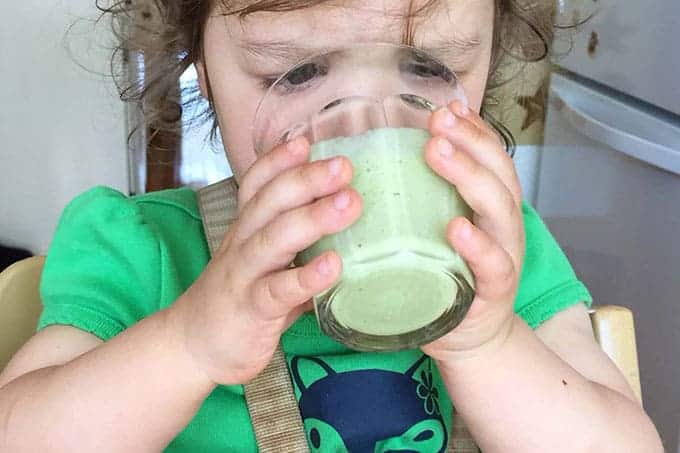
Best Tips for Success
Here are some tips to consider when making a fruit and veggie smoothie for your kids.
- If you can freeze the greens ahead of time, the finished product will taste much less “green” but will have the same nutrition. Just make sure the greens are dry, then put them into a zip top freezer bag and store in the freezer for up to 3 months.
- Blend really (really!) well to get a very smooth consistency, adding a little more milk (or even water) as needed to thin.
- You can get a less thick texture in toddler smoothies, which some kids prefer by using fresh fruit rather than frozen—and this is also a good option for winter days when a frozen drink is less than ideal.
- You can use yogurt in place of milk if you add a fruit with a lot of liquid like a clementine or orange.
- Try using half milk and half yogurt for a creamier texture some toddlers may prefer.
- Serve toddler smoothies in a reusable pouch (we like Squeasy Gear!) or in a cup with a straw.
- You can also offer small tastes with a spoon if you have a child who isn’t yet a fan. Consider even a small sampling a success!
- Sprinkle on some granola or a favorite cereal and serve as a smoothie bowl for a fun variation.
- And if nothing else works, freeze them into popsicles!
I’d love to know if you’ve tried this recipe and what your family thinks of it so please rate and comment below!
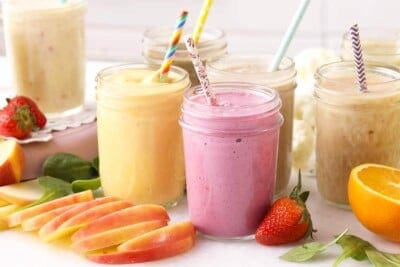
Favorite Healthy Toddler Smoothie (with Veggies!)
Ingredients
- 1 cup milk (I prefer nondairy)
- 1 small banana (fresh or frozen)
- 1/2 cup fresh or frozen fruit (such as blueberries, strawberries, mango, apple, or kiwi)
- 1/2 cup veggies (such as kale, spinach, raw fresh or frozen chopped cauliflower, raw fresh or frozen sliced zucchini, raw fresh or frozen sliced summer squash, roasted sweet potato, roasted butternut squash, steamed diced beets)
- Optional add ins (pick 1-2: 1 teaspoon hemp seeds, chia seeds, or ground flaxseed 1 tablespoon nut butter 2 tablespoons avocado 1-2 teaspoons cocoa powder 1-2 teaspoons honey or maple syrup 1 tablespoon rolled oats)
Instructions
- Add chosen ingredients to a blender.
- Blend until very smooth, stopping to scrape down the sides of the bowl and adding more liquid if needed.
- Serve immediately.
Equipment
Notes
- Blueberry Cocoa: Milk, banana, blueberries, spinach, cocoa powder
- Strawberry Banana: Milk, banana, strawberries, raw cauliflower, hemp seeds
- Mango Coconut Sweet Potato: Coconut milk, avocado, mango, sweet potato (cooked and cooled)
- Honey Peach: Milk, banana, peaches, raw summer squash, flaxseed
- Creamsicle: Yogurt, banana, orange, butternut squash (cooked and cooled)
- Tropical Greens: Milk, banana, kiwi, kale, chia seeds
- Cocoa Banana: Milk, banana (1 whole), spinach, cocoa powder, nut butter
- Tangy Peach: Kefir (instead of milk), banana, peach, honey, raw cauliflower
- Cinnamon Apple: Milk, banana, apple, raw summer squash, dash cinnamon
- Strawberry Beet: Milk, avocado, strawberries, raw beets (or leftover cooked), maple syrup
- If you can freeze the greens ahead of time, the finished product will taste much less “green” but will have the same nutrition. Just make sure the greens are dry, then put them into a zip top freezer bag and store in the freezer for up to 3 months.
- You can use raw cauliflower, zucchini, beets, and summer squash. (Or you can freeze those raw veggies and add them frozen.)
- You can add fully cooked and cooled sweet potato, butternut squash, and beets. (Any kind work, even leftover puree, as long as it’s not seasoned or salted.)
- Blend really (really!) well to get a very smooth consistency, adding a little more milk (or even water) as needed to thin.
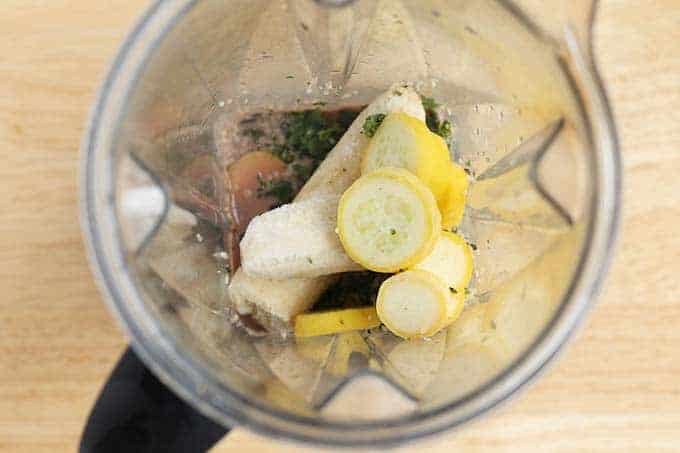
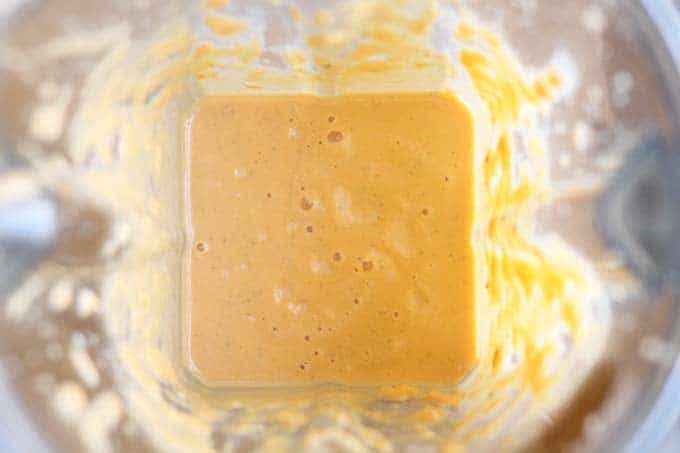
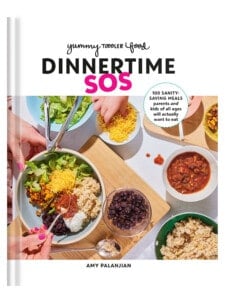
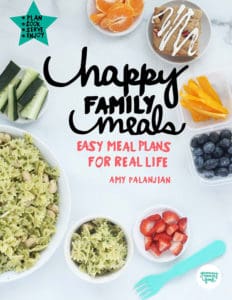
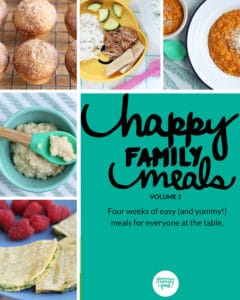
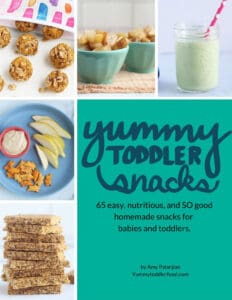














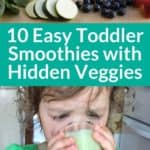
For seedy berries, would you recommend straining the smoothie before serving/storing? Whenever I make smoothies for myself and I use berries, frozen or fresh, there are so many seeds!
It may depend on your blender. The only berries I find this to be an issue with is raspberries and blackberries, so you could strain them (though with a thick mixture like a smoothie, that might be a little tricky) or just blend a little longer on the highest speed. I hope that helps!
Did not think strawberry beet would work, but it was so yummy!
Hi should the sweet potato be measured cooked cubed or just cooked scraped out of the skin…kinda mashed like.
Thank you for this recipe I’m using it to help replace a similar formula that I can no longer get ahold of for my special need son.
Hi- mash it into the measuring cup. I hope it works for him!
Love these smoothie ideas! What size smoothie is best for a one year old (as one serving)?
It really depends on the child, their appetite, and if it’s being served on it’s own or along with another food. With a baby or a one year old, 4 ounces may be the right fit. For an older kiddo, they could drink 8-12 ounces. We usually start with less and add more as needed in their cups to avoid waste.
Is using frozen butternut squash from the grocery freezer section okay or does the butternut squash need to be cooked first ?
That is almost always raw in the package so I think you’d need to cook it first as I’m not sure it would blend smooth if it’s used raw
This tasted great! My daughter only drank about 1 cup in a serving. What’s the best way to store in freezer for easy use next couple of days. Anything that saves me preparation on another day is pure gold 🙂
I’m so glad! You could freeze it in a reusable pouch if you have one or in an ice cub tray, then you could transfer the cubes to a cup the night before you plan to serve it and let it thaw in the fridge overnight.
Thanks, a few questions:
1. Which nondairy milk provides the best consistency?
2. For how long can I storage the smoothie in the fridge after blending the ingredients to make sure its still good to drink?
3. Which fruits or veggies should I avoid to prevent separation after blending?
Most nondairy milks offer a nice consistency. Ripple is super creamy, as is the protein milk from Silk. Smoothies are best consumed right after drinking. They are fine if stored in an airtight container in the fridge for up to 24 hours but they will not be as thick since they won’t be as frozen. I would not try to store a smoothie with blueberries as that tends to separate no matter what else is in it.
I really hate the taste and smell of banana. Is this something you can taste/smell in the smoothies, or is it kind of hidden like the veggies? Also wondering, if you can smell/taste it, can you replace it with mango for all the smoothies above? I noticed you mentioned that to someone else.
If you hate banana, I would use mango. You’ll likely be able to taste the banana in these.
Thanks for this. I love the benefits of cocao powder but I worry that it has caffeine. Do you know if the amount you suggest above would have impactful amount of caffeine? Thank you!
As far as I know the amounts are not concerning but if you are worried, you can reduce them or wait to use that ingredient.
I was looking for recipes to sneak more veggies into my 4 year old’s diet. Great idea with the frozen cauliflower – you can’t taste it at all. Thank you!
I’ve had good luck with packing my Ninja blender as full as possible with raw spinach, adding a can of coconut milk, about 16 ounces of almond milk or coconut water, blending, then topping up with frozen berries and an avocado. My toddler loves these (and hates just about everything it seems). I started making them for myself and we ended up sharing.
Has to be frozen fruit? I use fresh and water my baby is only 10 month old
You can use fresh. It will just be a little less thick.
Hi 👋 do you pack the veggies? For example, 1/2 cup of spinach, is that a packed 1/2 cup?
You can lightly pack the spinach!
Do I need to cook the spinach prior? My baby is 1 yo.
No, you can use fresh raw spinach
My baby is allergic to banana .., What can I replace with banana .., thank you
Mango works well instead.
How long can you store them for in the fridge?
Most would be best within 24 hours. You can also freeze leftovers into a popsicle mold too.
Just curious if there is any thoughts on this lasting until lunch time at school? My son needs to gain weight and improve his food options and is starting kindergarten. He loves smoothies but I want to serve them often since the only veggie he will eat is peas. Trying to figure out if I can stick one in the lunch box.
It should be fine if you pack it in an insulated lunchbox/bag. Blueberries often cause smoothies to separate when stored, so that’s the only fruit I would avoid. I hope he has a good start!